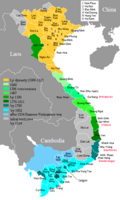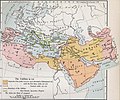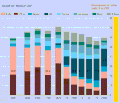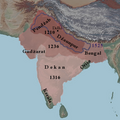Portal:Asia

 Asia (/ˈeɪʒə/ ⓘ AY-zhə, UK also /ˈeɪʃə/ AY-shə) is the largest continent in the world by both land area and population. It covers an area of more than 44 million square kilometres, about 30% of Earth's total land area and 8% of Earth's total surface area. The continent, which has long been home to the majority of the human population, was the site of many of the first civilisations. Its 4.7 billion people constitute roughly 60% of the world's population. Asia shares the landmass of Eurasia with Europe, and of Afro-Eurasia with both Europe and Africa. In general terms, it is bounded on the east by the Pacific Ocean, on the south by the Indian Ocean, and on the north by the Arctic Ocean. The border of Asia with Europe is a historical and cultural construct, as there is no clear physical and geographical separation between them. A commonly accepted division places Asia to the east of the Suez Canal separating it from Africa; and to the east of the Turkish straits, the Ural Mountains and Ural River, and to the south of the Caucasus Mountains and the Caspian and Black seas, separating it from Europe. Since the concept of Asia derives from the term for the eastern region from a European perspective, Asia is the remaining vast area of Eurasia minus Europe. Therefore, Asia is a region where various independent cultures coexist rather than sharing a single culture, and its boundary with Europe is somewhat arbitrary and has moved since its first conception in classical antiquity. The division of Eurasia into two continents reflects East–West cultural differences, some of which vary on a spectrum. (Full article...) Featured article Several attempts at a military alliance between the Frankish Crusaders and the Mongol Empire against the Islamic caliphates, their common enemy, were made by various leaders among them during the 13th century. Such an alliance might have seemed an obvious choice: the Mongols were already sympathetic to Christianity, given the presence of many influential Nestorian Christians in the Mongol court. The Franks—Western Europeans, and those in the Levantine Crusader states—were open to the idea of support from the East, in part owing to the long-running legend of the mythical Prester John, an Eastern king in an Eastern kingdom who many believed would one day come to the assistance of the Crusaders in the Holy Land. The Franks and Mongols also shared a common enemy in the Muslims. However, despite many messages, gifts, and emissaries over the course of several decades, the often-proposed alliance never came to fruition. Contact between Europeans and Mongols began around 1220, with occasional messages from the papacy and European monarchs to Mongol leaders such as the Great Khan, and subsequently to the Ilkhans in Mongol-conquered Persia. Communications tended to follow a recurring pattern: the Europeans asked the Mongols to convert to Western Christianity, while the Mongols responded with demands for submission and tribute. The Mongols had already conquered many Christian and Muslim states in their advance across Asia, and after destroying the Nizaris of Alamut and the Muslim Abbasid and Ayyubid dynasties, for the next few generations fought the remaining Islamic power in the region, the Egyptian Mamluks. Hethum I, king of the Christian state of Cilician Armenia, had submitted to the Mongols in 1247, and strongly encouraged other monarchs to engage in a Christian–Mongol alliance, but was only able to persuade his son-in-law, Prince Bohemond VI of the Crusader state of Antioch, who submitted in 1260. Other Christian leaders such as the Crusaders of Acre were more mistrustful of the Mongols, perceiving them as the most significant threat in the region. The Barons of Acre therefore engaged in an unusual passive alliance with the Muslim Mamluks, allowing Egyptian forces to advance unopposed through Crusader territory to engage and defeat the Mongols at the pivotal Battle of Ain Jalut in 1260. (Full article...) Selected Country Bangladesh, officially the People's Republic of Bangladesh, is a country in South Asia. It is the eighth-most populous country in the world and among the most densely populated with a population of over 171 million within an area of 148,460 square kilometres (57,320 sq mi). Bangladesh shares land borders with India to the north, west, and east, and Myanmar to the southeast. It has a coastline along the Bay of Bengal to its south and is separated from Bhutan and Nepal by the Siliguri Corridor, and from China by the Indian state of Sikkim to its north. Dhaka, the capital and largest city, is the nation's political, financial, and cultural centre. Chittagong is the second-largest city and the busiest port of the country. The territory of modern Bangladesh was a stronghold of many Buddhist and Hindu dynasties in ancient history. Following the Muslim conquest in 1204, the region saw Sultanate and Mughal rule. During the Mughal period, particularly under the Bengal Subah, the region emerged as one of the most prosperous and commercially active parts of the empire, known for its thriving textile industry and agricultural productivity. The Battle of Plassey in 1757 marked the beginning of British colonial rule for the following two centuries. In the aftermath of the Partition of British India in 1947, East Bengal became the eastern and most populous wing of the newly formed Dominion of Pakistan and was later renamed to East Pakistan. Following over two decades of political repression and systematic racism from the West Pakistan-based government, East Pakistan experienced a civil war in 1971; ultimately leading to a war for independence. The Mukti Bahini, with assistance from Indian forces, waged a successful armed revolution; and at the expense of a genocide, Bangladesh became a sovereign nation on 16 December 1971. Post-Independence, Sheikh Mujibur Rahman led the country until his assassination in 1975. Presidency was later transferred to Ziaur Rahman, who himself was assassinated in 1981. The 1980s was dominated by the dictatorship of Hussain Muhammad Ershad, who was overthrown in a mass uprising in 1990. Following the democratisation in 1991, the "Battle of the Begums" between Khaleda Zia and Sheikh Hasina defined the country's politics for the next three decades. Hasina was overthrown in a student–led mass uprising in August 2024, and an interim government led by Nobel laureate Muhammad Yunus was formed. (Full article...) Featured biographyRam Narayan (IPA: [raːm naːˈɾaːjəɳ]; 25 December 1927 – 9 November 2024), often referred to with the title Pandit, was an Indian musician who popularised the bowed instrument sarangi as a solo concert instrument in Hindustani classical music and became the first internationally successful sarangi player. Narayan was born near Udaipur and learned to play the sarangi at an early age. He studied under sarangi players and singers and, as a teenager, worked as a music teacher and travelling musician. All India Radio in Lahore hired Narayan as an accompanist for vocalists in 1944. Narayan relocated to Delhi following the partition of India in 1947, and moved to Mumbai in 1949 to work in Indian cinema. (Full article...) General imagesThe following are images from various Asia-related articles on Wikipedia. Featured picture Credit: Luca Galuzzi The north face of Mount Everest, as seen from Tibet. Everest is the highest mountain on Earth, as measured by the height of its summit above sea level, which is 8,848 metres (29,029 ft). In 1865, Everest was given its official English name by the Royal Geographical Society upon recommendation of Andrew Waugh, the British Surveyor General of India at the time.
Did you know...
Updated: 21:05, 24 June 2025 In the news
Related portalsMajor Religions in Asia Middle East (West Asia) Central Asia and Caucasus Indian Subcontinent Southeast Asia East Asia Selected panorama
The Ratchaprasong and Sukhumvit skylines of Bangkok, the capital of and largest city in Thailand, with Lumphini Park in the center, as viewed from the Sathon District. Known in Thai as Krung Thep ("city of angels"), it became the capital in 1768 after the destruction of Ayutthaya by Burmese invaders. TopicsCategoriesAssociated WikimediaThe following Wikimedia Foundation sister projects provide more on this subject:
More portalsShortcuts to this page: Asia portal • P:ASIA |





























































































